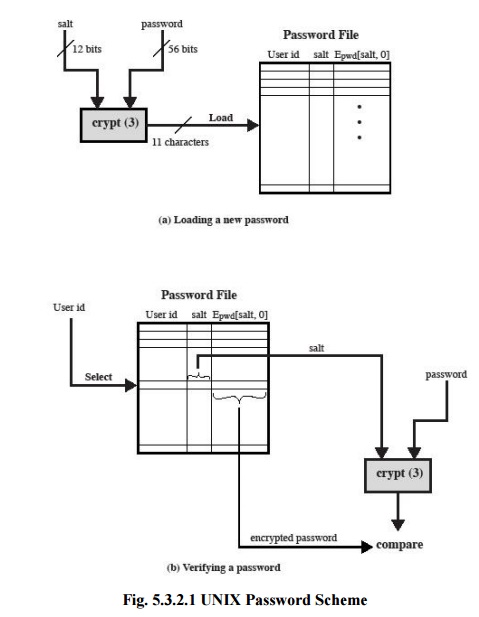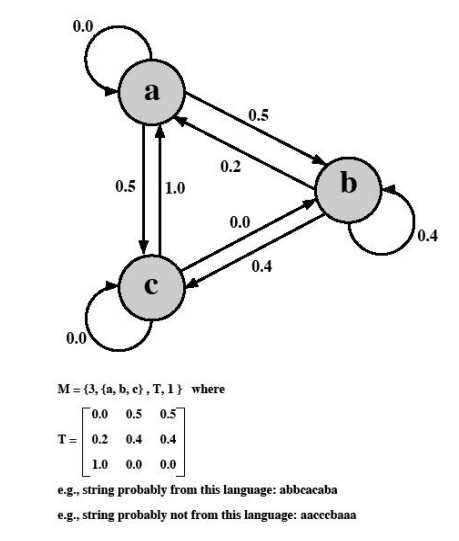Chapter: Cryptography and Network Security
Password Management
PASSWORD MANAGEMENT
1. Password Protection
The front
line of defense against intruders is the password system. Virtually all
multiuser systems require that a user provide not only a name or identifier
(ID) but also a password. The password serves to authenticate the ID of the
individual logging on to the system. In turn, the ID provides security in the
following ways:
· The ID
determines whether the user is authorized to gain access to a system.
·
The ID determines the privileges accorded to the
user.
·
The ID is used in ,what is referred to as
discretionary access control. For example, by listing the IDs of the other
users, a user may grant permission to them to read files owned by that user.
2. The Vulnerability of Passwords
To
understand the nature of the threat to password-based systems, let us consider
a scheme that is widely used on UNIX, the following procedure is employed.
·
Each user selects a password of up to eight
printable characters in length.
·
This is converted into a 56-bit value (using 7-bit
ASCII) that serves as the key input to an encryption routine.
·
The encryption routine, known as crypt(3), is based
on DES. The DES algorithm is modified using a 12-bit "salt" value.
·
Typically, this value is related to the time at
which the password is assigned to the user.
·
The modified DES algorithm is exercised with a data
input consisting of a 64-bit block of zeros.
·
The output of the algorithm then serves as input
for a second encryption.
·
This process is repeated for a total of 25
encryptions.
·
The resulting 64-bit output is then translated into
an 11-character sequence.
·
The hashed password is then stored, together with a
plaintext copy of the salt, in the password file for the corresponding user ID.
·
This method has been shown to be secure against a
variety of cryptanalytic attacks
The salt serves three purposes:
·
It prevents duplicate passwords from being visible
in the password file. Even if two users choose the same password, those
passwords will be assigned at different times. Hence, the "extended"
passwords of the two users will differ.
·
It effectively increases the length of the password
without requiring the user to remember two additional characters.
·
It prevents the use of a hardware implementation of
DES, which would ease the difficulty of a brute-force guessing attack.
When a
user attempts to log on to a UNIX system, the user provides an ID and a
password. The operating system uses the ID to index into the password file and
retrieve the plaintext salt and the encrypted password. The salt and
user-supplied password are used as input to the encryption routine. If the
result matches the stored value, the password is accepted.The encryption routine
is designed to discourage guessing attacks. Software implementations of DES are
slow compared to hardware versions, and the use of 25 iterations multiplies the
time required by 25.
Thus,
there are two threats to the UNIX password scheme. First, a user can gain
access on a machine using a guest account or by some other means and then run a
password guessing program, called a password cracker, on that machine.

As an
example, a password cracker was reported
on the Internet in August 1993. Using a Thinking Machines Corporation
parallel computer, a performance of 1560 encryptions per second per vector unit
was achieved. With four vector units per processing node (a standard
configuration), this works out to 800,000 encryptions per second on a 128-node
machine (which is a modest size) and 6.4 million encryptions per second on a
1024-node machine.
Password
length is only part of the problem. Many people, when permitted to choose their
own password, pick a password that is guessable, such as their own name, their
street name, a common dictionary word, and so forth. This makes the job of
password cracking straightforward.
Following
strategy was used:
Try the user's name, initials, account name, and other relevant personal
information. In all, 130 different permutations for each user were tried.
Try words from various dictionaries.
Try various permutations on the words from step 2.
Try various capitalization permutations on the words from step 2 that
were not considered in step 3. This added almost 2 million additional words to
the list.
3. Access Control
One way
to thwart a password attack is to deny the opponent access to the password
file. If the encrypted password portion of the file is accessible only by a
privileged user, then the opponent cannot read it without already knowing the
password of a privileged user.
Password Selection Strategies
Four
basic techniques are in use:
· User education
· Computer-generated passwords
· Reactive password checking
· Proactive password checking
Users can
be told the importance of using hard-to-guess passwords and can be provided
with guidelines for selecting strong passwords. This user education strategy is unlikely to succeed at most
installations, particularly where there is a large user population or a lot of
turnover. Many users will simply ignore the guidelines
Computer-generated passwords also have
problems. If the passwords are quite random in nature, users will not be able to remember them. Even if the
password is pronounceable, the user may have difficulty remembering it and so
be tempted to write it down
A reactive password checking
strategy is one in which the system periodically runs its own password cracker to find guessable
passwords.
The most
promising approach to improved password security is a proactive password checker. In this scheme, a user is allowed to
select his or her own password. However, at the time of selection, the system
checks to see if the password is allowable and, if not, rejects it. Such
checkers are based on the philosophy that, with sufficient guidance from the
system, users can select memorable passwords from a fairly large password space
that are not likely to be guessed in a dictionary attack.
The first
approach is a simple system for rule enforcement. For example, the following
rules could be enforced:
·
All passwords must be at least eight characters
long.
·
In the first eight characters, the passwords must
include at least one each of uppercase, lowercase, numeric digits, and
punctuation marks. These rules could be coupled with advice to the user.
Although this approach is superior to simply educating users, it may not be
sufficient to thwart password crackers. This scheme alerts crackers as to which
passwords not to try but may still make it possible to do password cracking.
Another
possible procedure is simply to compile a large dictionary of possible
"bad" passwords. When a user selects a password, the system checks to
make sure that it is not on the disapproved list.
There are
two problems with this approach:
· Space:
The dictionary must be very large to be effective..
·
Time: The time required to search a large
dictionary may itself be large
Two
techniques for developing an effective and efficient proactive password checker
that is based on rejecting words on a list show promise. One of these develops
a Markov model for the generation of guessable passwords. This model shows a
language consisting of an alphabet of three characters. The state of the system
at any time is the identity of the most recent letter. The value on the
transition from one state to another represents the probability that one letter
follows another. Thus, the probability that the next letter is b, given that
the current letter is a, is 0.5.
In
general, a Markov model is a quadruple [m, A, T, k], where m is the number of
states in the model, A is the state space, T is the matrix of transition
probabilities, and k is the order of the model. For a kth-order model, the
probability of making a transition to a particular letter depends on the
previous k letters that have been generated.

The
authors report on the development and use of a second-order model. To begin, a
dictionary of guessable passwords is constructed. Then the transition matrix is
calculated as follows:
1. Determine
the frequency matrix f, where f(i, j, k) is the number of occurrences of the
trigram consisting of the ith, jth, and kth character. For example, the
password parsnips yields the trigrams par, ars, rsn, sni, nip, and ips.
2. For each
bigram ij, calculate f(i, j,∞) as the total number of trigrams beginning with
ij. For example, f(a, b,∞) would be the total number of trigrams of the form
aba, abb, abc, and so on.
3. Compute
the entries of T as follows:
T(i,j,k) = f(i, j, k) / f(i, j,∞)
The
result is a model that reflects the structure of the words in the dictionary.
A quite
different approach has been reported by Spafford. It is based on the use of a
Bloom filter. To begin, we explain the operation of the Bloom filter. A Bloom
filter of order k consists of a set of k independent hash functions H1(x),
H2(x),..., Hk(x), where each function maps a password
into a hash value in the range 0 to N - 1 That is,
Hi(Xj) = y
1 ≤i ≤k; 1 ≤j ≤D; 0 ≤y ≤N- 1
where
Xj = jth word in password dictionary
D = number of words in password dictionary
The
following procedure is then applied to the dictionary:
·
A hash table of N bits is defined, with all bits
initially set to 0.
·
For each password, its k hash values are
calculated, and the corresponding bits in the hash table are set to 1. Thus, if
Hi(Xj) = 67 for some (i, j), then the sixty-seventh bit
of the hash table is set to 1; if the bit already has the value 1, it
remains
at 1.
When a
new password is presented to the checker, its k hash values are calculated. If
all the corresponding bits of the hash table are equal to 1, then the password
is rejected.
Related Topics